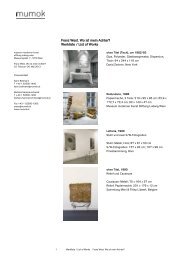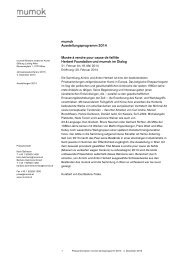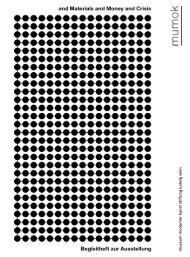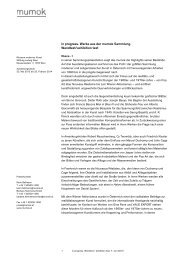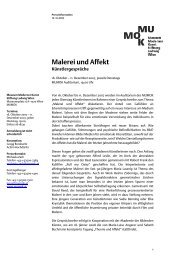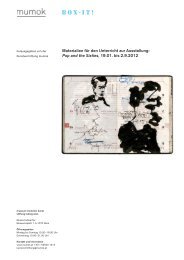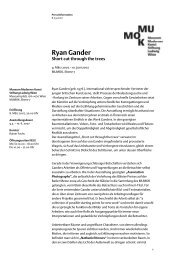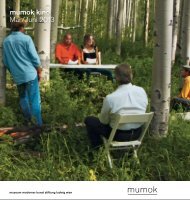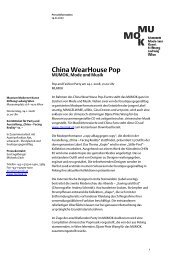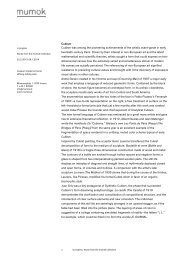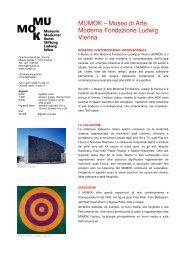in progress. Werke aus der mumok Sammlung Wandtext/exhibition text
in progress. Werke aus der mumok Sammlung Wandtext/exhibition text
in progress. Werke aus der mumok Sammlung Wandtext/exhibition text
Erfolgreiche ePaper selbst erstellen
Machen Sie aus Ihren PDF Publikationen ein blätterbares Flipbook mit unserer einzigartigen Google optimierten e-Paper Software.
Museum mo<strong>der</strong>ner Kunst<br />
Stiftung Ludwig Wien<br />
Museumsplatz 1 | 1070 Wien<br />
Ausstellungsdauer<br />
22. Februar 2013 bis 26. Jänner 2014<br />
Pressekontakt<br />
Kar<strong>in</strong> Bellmann<br />
T +43 1 52500-1400<br />
kar<strong>in</strong>.bellmann@<strong>mumok</strong>.at<br />
Barbara Hammerschmied<br />
T +43 1 52500-1450<br />
barbara.hammerschmied@<strong>mumok</strong>.at<br />
Fax +43 1 52500-1300<br />
press@<strong>mumok</strong>.at<br />
www.<strong>mumok</strong>.at<br />
<strong>in</strong> <strong>progress</strong>. <strong>Werke</strong> <strong>aus</strong> <strong>der</strong> <strong>mumok</strong> <strong>Sammlung</strong><br />
<strong>Wand<strong>text</strong></strong>/<strong>exhibition</strong> <strong>text</strong><br />
Strenge Abstraktion<br />
Ausgehend vom Kubismus <strong>in</strong> Frankreich, entstanden <strong>in</strong> Europa zu Beg<strong>in</strong>n des 20.<br />
Jahrhun<strong>der</strong>ts verschiedene Ausprägungen e<strong>in</strong>er strengen geometrischen<br />
Abstraktion. Bevor Piet Mondrian <strong>in</strong> den Nie<strong>der</strong>landen die Gruppe De Stijl<br />
mitbegründete, studierte er <strong>in</strong> Paris die <strong>Werke</strong> von Pablo Picasso und Georges<br />
Braque. Aus <strong>der</strong> Formzerlegung und Zerglie<strong>der</strong>ung des Bildraums im Kubismus<br />
entwickelte er se<strong>in</strong> Pr<strong>in</strong>zip e<strong>in</strong>er „re<strong>in</strong>en Abstraktion“, die sich auf die Primärfarben<br />
Rot, Blau und Gelb, die Nichtfarben Schwarz, Weiß und Grau sowie auf vertikale und<br />
horizontale L<strong>in</strong>ien beschränkte. Mit diesen Gestaltungselementen suchte Mondrian<br />
e<strong>in</strong> Gleichgewicht herzustellen, e<strong>in</strong>e Harmonie <strong>der</strong> Teile untere<strong>in</strong>an<strong>der</strong>, als Spiegel<br />
e<strong>in</strong>er universellen Harmonie. Die Komposition mit Doppell<strong>in</strong>ie und Blau von 1934<br />
gewährt durch ihren unvollendeten Zustand E<strong>in</strong>blick <strong>in</strong> Mondrians behutsame und<br />
<strong>in</strong>tuitive Arbeitsweise: In e<strong>in</strong>em schwarzen L<strong>in</strong>iengerüst s<strong>in</strong>d zwei mit Kohle skizzierte<br />
Querl<strong>in</strong>ien und unbemalte Partien erkennbar, die auf e<strong>in</strong>e nicht mehr <strong>aus</strong>geführte<br />
Än<strong>der</strong>ung <strong>der</strong> Komposition h<strong>in</strong>deuten.<br />
Der gebürtige Ungar László Moholy-Nagy entwickelte e<strong>in</strong>en geometrischen<br />
Konstruktivismus eigener Ausprägung, wie Komposition Q VIII (1922) belegt. Vor<br />
e<strong>in</strong>em fe<strong>in</strong> schattierten grauen Untergrund schweben <strong>in</strong> <strong>aus</strong>gewogener Balance<br />
transparente geometrische Formen, <strong>der</strong>en gegenseitige Durchdr<strong>in</strong>gung e<strong>in</strong>e<br />
räumliche Spannung erzeugt. Nur die schwarzen Elemente geben <strong>der</strong> Komposition<br />
Halt und Struktur. Moholy-Nagys Bildidee geht auf Experimente mit Licht und <strong>der</strong><br />
Transparenz von durchsichtigen Materialien <strong>aus</strong> Architektur und Skulptur zurück.<br />
1923 wurde Moholy-Nagy von Walter Gropius an das Weimarer Bauh<strong>aus</strong> berufen,<br />
dessen technisch-konstruktivistische Ausrichtung er mitprägte.<br />
In Deutschland gehörte Walter Dexel zu den Künstlern, die versuchten, die Pr<strong>in</strong>zipien<br />
<strong>der</strong> strengen geometrischen Abstraktion <strong>in</strong> den Bereichen <strong>der</strong> Werbung und <strong>der</strong><br />
Alltagskultur zu verankern. Als Maler, Werbegrafiker und Designer wollte er se<strong>in</strong>e<br />
Vorstellung e<strong>in</strong>er „bildimmanenten Syntax“ <strong>in</strong> allen Funktionsbereichen des urbanen<br />
Alltags angewandt wissen. Architektur, Raumgestaltung und Kunstgewerbe als<br />
„vorbildliche <strong>in</strong>dustrielle und handwerkliche Erzeugnisse“ standen für ihn im<br />
Vor<strong>der</strong>grund des Interesses, Bil<strong>der</strong><strong>aus</strong>stellungen sah er als „Teil e<strong>in</strong>es Ganzen“.<br />
Diesen Formen abstrakter Kunst, die e<strong>in</strong>em konstruktiven, geometrischen Bildaufbau<br />
verpflichtet waren und <strong>in</strong> Gebrauchsgrafik und Alltagsgestaltung Verwendung<br />
fanden, stand Robert Delaunay ablehnend gegenüber. Mit dem Ziel e<strong>in</strong>er „re<strong>in</strong>en<br />
Malerei“ wollte er <strong>in</strong> e<strong>in</strong>em radikalen Bruch den traditionellen konstruktiven Aspekt<br />
<strong>der</strong> Malerei wi<strong>der</strong>legen. Se<strong>in</strong>e Vorstellung e<strong>in</strong>er „re<strong>in</strong>en Malerei <strong>der</strong> Farbe“, <strong>in</strong> <strong>der</strong><br />
Farbe zugleich Inhalt und Form ist, wird im Relief blanc von 1936 durch die<br />
Elim<strong>in</strong>ierung <strong>der</strong> Farbe zugunsten e<strong>in</strong>er Malerei durch das immaterielle Licht des<br />
Raums gleichsam zu e<strong>in</strong>em experimentellen Höhepunkt gebracht.<br />
1 21. Februar 2013
Pure Abstraction<br />
The advent of Cubism <strong>in</strong> France spawned several different strands of strict geometric<br />
abstraction <strong>in</strong> early twentieth-century Europe. Prior to co-found<strong>in</strong>g the De Stijl group<br />
<strong>in</strong> the Netherlands, Piet Mondrian had studied the works of Picasso and Braque <strong>in</strong><br />
Paris. Start<strong>in</strong>g from Cubism’s dissolution of form and dissection of pictorial space,<br />
Mondrian developed his pr<strong>in</strong>ciple of “pure abstraction” restricted to the primary<br />
colors red, blue, and yellow, to the noncolors black, white, and gray, and to vertical<br />
and horizontal l<strong>in</strong>es. Us<strong>in</strong>g these artistic elements, Mondrian sought to achieve a<br />
balance, a harmony between the parts, as a reflection of a universal harmony. The<br />
unf<strong>in</strong>ished state of his Composition with Double L<strong>in</strong>e and Blue of 1934 affords us an<br />
<strong>in</strong>sight <strong>in</strong>to Mondrian’s cautious and <strong>in</strong>tuitive work<strong>in</strong>g method: the pa<strong>in</strong>t<strong>in</strong>g’s<br />
framework of black l<strong>in</strong>es conta<strong>in</strong>s with<strong>in</strong> it two l<strong>in</strong>es sketched <strong>in</strong> charcoal as well as<br />
unpa<strong>in</strong>ted areas, suggest<strong>in</strong>g a modification of the composition that was not actually<br />
carried out.<br />
The Hungarian-born László Moholy-Nagy developed his own dist<strong>in</strong>ctive geometric<br />
Constructivism, as seen <strong>in</strong> his Composition Q VIII of 1922. Here, transparent,<br />
geometric forms float <strong>in</strong> a state of suspension before a f<strong>in</strong>ely shaded gray<br />
background, their <strong>in</strong>terpenetration generat<strong>in</strong>g spatial tension. Only the black<br />
elements provide the composition with a secure “hold” and structure. Moholy-Nagy’s<br />
pictorial concept is <strong>der</strong>ived from experiments with light and transparent materials <strong>in</strong><br />
the mediums of architecture and sculpture. In 1923, Walter Gropius <strong>in</strong>vited Moholy-<br />
Nagy to teach at the Bauh<strong>aus</strong> <strong>in</strong> Weimar, where he would have a formative <strong>in</strong>fluence<br />
on the school’s technical and Constructivist orientation.<br />
In Germany, Walter Dexel was one of a number of artists who tried to anchor the<br />
pr<strong>in</strong>ciples of strict geometric abstraction <strong>in</strong> the worlds of advertis<strong>in</strong>g and everyday<br />
culture. As a pa<strong>in</strong>ter, commercial artist, and designer he wanted his idea of the<br />
“syntax <strong>in</strong>herent <strong>in</strong> the image” to be used <strong>in</strong> all practical areas of everyday urban life.<br />
Architecture, <strong>in</strong>terior design, and applied arts as “exemplary <strong>in</strong>dustrial and<br />
handcrafted products” were of paramount <strong>in</strong>terest to him; he viewed pa<strong>in</strong>t<strong>in</strong>g<br />
<strong>exhibition</strong>s as only “part of a whole.”<br />
It was precisely these forms of abstract art—beholden to a constructional, geometric,<br />
compositional structure and put to use <strong>in</strong> commercial art and everyday design—that<br />
Robert Delaunay disapproved of. With “pure pa<strong>in</strong>t<strong>in</strong>g” as his objective, he sought a<br />
radical break with the traditional constructional aspect of pa<strong>in</strong>t<strong>in</strong>g, even at the cost of<br />
its destruction. Delaunay’s supremely experimental Relief Blanc of 1936 takes his<br />
notion of “pure color pa<strong>in</strong>t<strong>in</strong>g”—<strong>in</strong> which color is both form and content—a stage<br />
further by elim<strong>in</strong>at<strong>in</strong>g color <strong>in</strong> favor of the pa<strong>in</strong>t<strong>in</strong>g of light.<br />
2 21. Februar 2013
Surrealismus<br />
Die <strong>in</strong> den frühen 1920er-Jahren von Paris <strong>aus</strong>gehende Bewegung des Surrealismus<br />
versuchte das Unwirkliche und Traumhafte <strong>der</strong> gesellschaftlichen Realität sowie die<br />
Tiefen des Unbewussten <strong>aus</strong>zuloten und darzustellen. 1924 plädierte André Breton<br />
<strong>in</strong> se<strong>in</strong>em Manifeste du surréalisme für e<strong>in</strong>e Aufhebung <strong>der</strong> Wi<strong>der</strong>sprüche von<br />
Irrealität und Realität <strong>in</strong> e<strong>in</strong>er absoluten „Überwirklichkeit“, <strong>in</strong> <strong>der</strong> gewohnte Denk-<br />
und Wahrnehmungsarten ihre Geltung verloren haben. Die Bekanntschaft mit Breton<br />
und den Pariser Surrealisten bee<strong>in</strong>flusste André Masson <strong>in</strong> <strong>der</strong> Entwicklung e<strong>in</strong>er<br />
Kunst jenseits rationaler Überlegungen, die mithilfe <strong>der</strong> „écriture automatique“, des<br />
„automatischen Schreibens“, Zugang zum Irrationalen und Unbewussten suchte.<br />
Dar<strong>aus</strong> entwickelte Masson e<strong>in</strong>e Methode <strong>der</strong> Bildf<strong>in</strong>dung <strong>aus</strong> Leim und Sand, die er<br />
mit spontaner Malerei vollendete und assoziativ betitelte – wie <strong>in</strong> Oiseaux („Vögel“)<br />
von 1927.<br />
Erst bei genauer Betrachtung ist erkennbar, dass Max Ernst für Êtes-vous N<strong>in</strong>iche?<br />
(1955–1956) banale gefundene Elemente komb<strong>in</strong>ierte. Zwei Ochsenjoche montierte<br />
er zu e<strong>in</strong>er Skulptur, <strong>der</strong>en starr frontaler Aufbau an e<strong>in</strong>e archaische Kultstatue<br />
er<strong>in</strong>nert. Das Wort „N<strong>in</strong>iche“ ist auf e<strong>in</strong>er Druckplatte, die als Boden dient, zu sehen.<br />
Der Titel führt <strong>in</strong> die Irre: Die direkt an uns gerichtete Frage: „S<strong>in</strong>d Sie N<strong>in</strong>iche?“,<br />
verleitet zum <strong>in</strong>terpretativen Ausdeuten <strong>der</strong> e<strong>in</strong>zelnen Elemente, die ke<strong>in</strong>en<br />
Zusammenhang besitzen. Masken, Fabelwesen und Kultstatuen s<strong>in</strong>d Teil <strong>der</strong><br />
geheimnisvoll-abgründigen Bil<strong>der</strong>welt, die Ernst nach dem Zweiten Weltkrieg<br />
verstärkt beschäftigte.<br />
Mit e<strong>in</strong>deutig vertrauten Objekten, <strong>der</strong>en paradoxe Verfälschung erst auf den zweiten<br />
Blick irritiert, arbeitet René Magritte. La Voix du sang („Die Stimme des Blutes“,<br />
1959) zeigt e<strong>in</strong>en monumentalen Baum <strong>in</strong> e<strong>in</strong>er weiten nächtlichen Landschaft.<br />
Ähnlich e<strong>in</strong>em Schrank ist <strong>der</strong> Stamm geöffnet: E<strong>in</strong> H<strong>aus</strong> und e<strong>in</strong>e Kugel verwirren<br />
beim Betrachten die Vorstellung von realen Größenverhältnissen. Magritte untergräbt<br />
unsere falsche Vertrautheit mit alltäglichen D<strong>in</strong>gen. Die E<strong>in</strong>heit von Bild und Begriff<br />
löst sich auf, und die D<strong>in</strong>ge beg<strong>in</strong>nen ihre Bedeutung zu verän<strong>der</strong>n: „Man muss<br />
immer unterscheiden zwischen dem, was e<strong>in</strong>e Sache bezeichnet, und <strong>der</strong> Idee, die<br />
man von e<strong>in</strong>er Sache hat.“<br />
Surrealism<br />
Orig<strong>in</strong>at<strong>in</strong>g <strong>in</strong> Paris <strong>in</strong> the early twenties, Surrealism was a movement that attempted<br />
to probe and portray the unreal, dreamlike character of social reality, and to plumb<br />
the depths of the unconscious. In his Surrealist Manifesto of 1924, André Breton<br />
pleaded for the contradictory states of unreality and reality to be reconciled <strong>in</strong> an<br />
absolute “surreality,” where the usual ways of th<strong>in</strong>k<strong>in</strong>g and perceiv<strong>in</strong>g would no<br />
longer be valid. His acqua<strong>in</strong>tance with Breton and the Parisian Surrealists <strong>in</strong>fluenced<br />
the artist André Masson <strong>in</strong> his development of an art removed from rational<br />
consi<strong>der</strong>ations—an art that with the aid of écriture automatique (automatic writ<strong>in</strong>g)<br />
could access the irrational and the depths of the unconscious. Masson devised a<br />
method of pictorial <strong>in</strong>vention that <strong>in</strong>corporated glue and sand; works were then<br />
3 21. Februar 2013
f<strong>in</strong>ished with an act of spontaneous pa<strong>in</strong>t<strong>in</strong>g and assigned associative titles—as <strong>in</strong><br />
Oiseaux (Birds) of 1927.<br />
Max Ernst’s Étes-vous N<strong>in</strong>iche? (Are You N<strong>in</strong>iche?) of 1955–56 is a comb<strong>in</strong>ation of<br />
commonplace found elements—a fact that is often noticed only upon closer<br />
<strong>in</strong>spection of the work. The artist mounted two ox yokes to create a sculpture whose<br />
rigidly frontal composition recalls an archaic cult statue. The name “N<strong>in</strong>iche” appears<br />
on the pr<strong>in</strong>t<strong>in</strong>g plate that functions as a base. The title is deliberately mislead<strong>in</strong>g: a<br />
question addressed directly to the viewer, it encourages the <strong>in</strong>terpretation of<br />
<strong>in</strong>dividual elements which <strong>in</strong> fact have no connection. Masks, mythical figures, and<br />
cult statues were all part of Ernst’s mysterious, cryptic visual world, and he became<br />
<strong>in</strong>creas<strong>in</strong>gly preoccupied with such th<strong>in</strong>gs after World War II.<br />
René Magritte worked with dist<strong>in</strong>ctly familiar objects, to which he lent a paradoxical,<br />
distort<strong>in</strong>g twist that proves disconcert<strong>in</strong>g only upon second glance. La voix du sang<br />
(The Voice of Blood) of 1959 features an immense tree <strong>in</strong> a vast nocturnal<br />
landscape. The tree’s trunk is opened up like a cupboard, reveal<strong>in</strong>g a house and a<br />
sphere that confuse the viewer’s sense of scale. In his work, Magritte un<strong>der</strong>m<strong>in</strong>es<br />
our false familiarity with everyday th<strong>in</strong>gs. The unity of image and concept dissolves,<br />
and the mean<strong>in</strong>gs of th<strong>in</strong>gs beg<strong>in</strong> to shift: “A dist<strong>in</strong>ction must always be made<br />
between what a th<strong>in</strong>g signifies and the idea one has of th<strong>in</strong>g.”<br />
4 21. Februar 2013
Bauh<strong>aus</strong><br />
Die 1919 von Walter Gropius <strong>in</strong> Weimar begründete Kunsthochschule Bauh<strong>aus</strong><br />
suchte im Zusammenwirken aller Künste e<strong>in</strong>e Synthese <strong>aus</strong> Kunst, Handwerk und<br />
<strong>in</strong>dustrieller Serienproduktion zu schaffen, die <strong>der</strong> Kunst <strong>in</strong> <strong>der</strong> mo<strong>der</strong>nen<br />
Lebenswelt e<strong>in</strong>en Platz gibt. Unter den Maximen „Sachlichkeit“, „Funktionalität“ und<br />
„soziale Verantwortung“ fanden sich Lehrer wie Wassily Kand<strong>in</strong>sky, Lyonel Fe<strong>in</strong><strong>in</strong>ger,<br />
Paul Klee, Oskar Schlemmer, Ludwig Mies van <strong>der</strong> Rohe und Herbert Bayer<br />
zusammen. Seit 1925 <strong>in</strong> Dessau und seit 1932 <strong>in</strong> Berl<strong>in</strong> ansässig, wurde das<br />
Bauh<strong>aus</strong> 1933 von den Nationalsozialisten geschlossen.<br />
Ab 1922 unterrichtete Wassily Kand<strong>in</strong>sky am Bauh<strong>aus</strong> als Meister für Wandmalerei<br />
und allgeme<strong>in</strong>e Formenlehre. Trotzig (1933) zeigt Kand<strong>in</strong>skys Vorbehalt gegenüber<br />
<strong>der</strong> Verabsolutierung re<strong>in</strong> konstruktivistischer Bildpr<strong>in</strong>zipien, wie sie am Bauh<strong>aus</strong><br />
propagiert wurden. Die Abstraktion war für Kand<strong>in</strong>sky Ausdruck e<strong>in</strong>er geistigen<br />
Ordnung, <strong>in</strong> <strong>der</strong> Farben und Formen <strong>in</strong> Entsprechung zur Musik wie Klänge<br />
harmonisch o<strong>der</strong> dissonant aufe<strong>in</strong>an<strong>der</strong> abgestimmt s<strong>in</strong>d. In Trotzig schweben auf<br />
e<strong>in</strong>em roten Grund fe<strong>in</strong> nuancierte geometrische Flächen <strong>in</strong> rhythmischer<br />
Ausgewogenheit. Alle<strong>in</strong> <strong>der</strong> Bildtitel suggeriert e<strong>in</strong>e gegenständliche Referenz:<br />
Trotzig sche<strong>in</strong>t e<strong>in</strong> Tier se<strong>in</strong>en Kopf von e<strong>in</strong>em roten Himmelskörper abzuwenden. In<br />
Anlehnung an Paul Klee überführt Kand<strong>in</strong>sky se<strong>in</strong>e abstrakten Formen <strong>in</strong>s Intuitiv-<br />
Poetische und ironisiert damit den rational-abstrakten Ansatz des Bauh<strong>aus</strong>es.<br />
Boote und Klippen entsteht 1927, während Paul Klee am Dessauer Bauh<strong>aus</strong> als<br />
Lehrer wirkt. Es trägt die typischen Züge des strengen Konstruktivismus, <strong>der</strong> jedoch<br />
durch Klees Gespür für Humor und Poesie entschärft wird. Sich immer wie<strong>der</strong><br />
überkreuzende L<strong>in</strong>ien umschreiben entlang <strong>der</strong> Berührungsl<strong>in</strong>ie zweier horizontaler<br />
Farbbän<strong>der</strong> geometrische Flächen, die <strong>in</strong> leuchtenden Farben <strong>aus</strong>gefüllt s<strong>in</strong>d. Die<br />
spielerisch anmutende Gestaltungsweise verweist auf die Vorstellung vom<br />
unbewussten, <strong>aus</strong> dem <strong>in</strong>neren Impuls geborenen Schöpfungsakt, den Klee als<br />
Analogie zur Weltschöpfung versteht. Der Titel ist poetischer Kommentar und schafft<br />
e<strong>in</strong>e Verb<strong>in</strong>dung zwischen selbstständigen, re<strong>in</strong> bildnerischen Mitteln und<br />
gegenständlicher Assoziation.<br />
Zwischen 1920 und 1928 lehrt Oskar Schlemmer am Bauh<strong>aus</strong>, zunächst als Leiter<br />
<strong>der</strong> Werkstatt für Wandmalerei, dann für Ste<strong>in</strong>bildhauerei und Bühne. Im Mittelpunkt<br />
dieses vielfältigen Wirkens steht Schlemmers Bemühen um die menschliche Figur <strong>in</strong><br />
ihrer Beziehung zum Raum. Dabei strebt er e<strong>in</strong>en ideal mo<strong>der</strong>nen und zeitlosen<br />
Menschentypus an. Abstrakte Figur (1921) ist Schlemmers e<strong>in</strong>zige figürliche Plastik.<br />
Die im eleganten Wechselspiel von Schale und Kern auf geometrische Grundformen<br />
reduzierte Figur ersche<strong>in</strong>t wie e<strong>in</strong> Idol, als zeichenhafter Typus des mo<strong>der</strong>nen<br />
Menschen <strong>in</strong> e<strong>in</strong>er von Technik und Rationalität bestimmten Zeit. Die Ausführung <strong>in</strong><br />
vernickelter Bronze erzeugt e<strong>in</strong>e glänzende, das Licht reflektierende Oberfläche,<br />
welche die Figur alles Materiellen enthebt und <strong>in</strong>s Zeitlose entrückt.<br />
5 21. Februar 2013
Bauh<strong>aus</strong><br />
Founded by Walter Gropius <strong>in</strong> Weimar <strong>in</strong> 1919, the Bauh<strong>aus</strong> art school sought an<br />
<strong>in</strong>teraction of all the arts that would br<strong>in</strong>g about a synthesis of art, craft, and<br />
<strong>in</strong>dustrial mass production and <strong>in</strong> do<strong>in</strong>g so secure art’s place <strong>in</strong> mo<strong>der</strong>n life.<br />
Teachers at the school, <strong>in</strong>clud<strong>in</strong>g Wassily Kand<strong>in</strong>sky, Lyonel Fe<strong>in</strong><strong>in</strong>ger, Paul Klee,<br />
Oskar Schlemmer, Ludwig Mies van <strong>der</strong> Rohe, and Herbert Bayer, united around the<br />
pr<strong>in</strong>ciples of objectivity, functionality, and social responsibility. After mov<strong>in</strong>g to<br />
Dessau <strong>in</strong> 1925, and then to Berl<strong>in</strong> <strong>in</strong> 1932, the Bauh<strong>aus</strong> was closed by the Nazis <strong>in</strong><br />
1933.<br />
Wassily Kand<strong>in</strong>sky jo<strong>in</strong>ed the Bauh<strong>aus</strong> faculty <strong>in</strong> 1922 as master for mural pa<strong>in</strong>t<strong>in</strong>g<br />
and the theory of form. Trotzig (Obst<strong>in</strong>ate) of 1933 reveals his reservations vis-à-vis<br />
the absolutism of the purely Constructivist pictorial pr<strong>in</strong>ciples propagated by the<br />
Bauh<strong>aus</strong>. Kand<strong>in</strong>sky saw abstraction as the expression of a spiritual or<strong>der</strong>, where<br />
colors and forms are coord<strong>in</strong>ated <strong>in</strong> consonant or dissonant relationships, the way<br />
sounds are <strong>in</strong> music. In Trotzig, f<strong>in</strong>ely nuanced geometric planes float <strong>in</strong> rhythmic<br />
balance on a red ground. Only <strong>in</strong> the work’s title is there any suggestion of a<br />
concrete reference: an “obst<strong>in</strong>ate” animal seems to be turn<strong>in</strong>g its head away from a<br />
red celestial body. Follow<strong>in</strong>g the example of Paul Klee, Kand<strong>in</strong>sky translated his<br />
abstract forms <strong>in</strong>to someth<strong>in</strong>g <strong>in</strong>tuitive and poetic, thus giv<strong>in</strong>g an ironic sp<strong>in</strong> to the<br />
Bauh<strong>aus</strong>’s rational-abstract approach.<br />
Klee himself pa<strong>in</strong>ted his Boote und Klippen (Boats and Cliffs) <strong>in</strong> 1927 while a teacher<br />
at the Dessau Bauh<strong>aus</strong>. The pa<strong>in</strong>t<strong>in</strong>g displays the characteristics typical of strict<br />
Constructivism, albeit softened by Klee’s sense of humor and feel<strong>in</strong>g for poetry.<br />
Here, geometric surfaces def<strong>in</strong>ed by <strong>in</strong>tersect<strong>in</strong>g l<strong>in</strong>es and filled out <strong>in</strong> brilliant colors<br />
are assembled along the l<strong>in</strong>e where two horizontal bands of color make contact. The<br />
seem<strong>in</strong>g playfulness of the composition is suggestive of an unconscious act of<br />
creation born of an <strong>in</strong>ner impulse—an act of creation that Klee saw as analogous to<br />
the creation of the world. The title is a poetic commentary and forges a l<strong>in</strong>k between<br />
autonomous, purely artistic means and figurative association.<br />
Oskar Schlemmer taught at the Bauh<strong>aus</strong> from 1920 to 1928, first as head of the<br />
mural-pa<strong>in</strong>t<strong>in</strong>g workshop and later for the stone-sculpture and stage workshops. As<br />
varied as Schlemmer’s activities were, the focus of his attention rema<strong>in</strong>ed the human<br />
figure and its relation to space. He strove for an ideal, mo<strong>der</strong>n, and timeless human<br />
type. Abstrakte Figur (Abstract Figure) of 1921 is Schlemmer’s only figurative<br />
sculpture. Reduced to basic geometric forms <strong>in</strong> an elegant <strong>in</strong>terplay of shell and<br />
core, the figure resembles an idol, a symbol of mo<strong>der</strong>n man <strong>in</strong> an age def<strong>in</strong>ed by<br />
technology and rationality. The execution <strong>in</strong> nickel-plated bronze results <strong>in</strong> a sh<strong>in</strong>y,<br />
light-reflect<strong>in</strong>g surface that releases the figure from its materiality, deliver<strong>in</strong>g it <strong>in</strong>to a<br />
timeless realm.<br />
6 21. Februar 2013
Expressionismus<br />
Nur wenige Jahre nach <strong>der</strong> Wende <strong>in</strong>s 20. Jahrhun<strong>der</strong>t wurde die stilisierte,<br />
ornamentale Formensprache des Jugendstils <strong>in</strong> verschiedenen expressiven<br />
Tendenzen aufgelöst. Während etwa Kolo Mosers pastellfarbene Lichtwesen<br />
Drei Frauen (um 1914) die Darstellung des Menschen symbolisch zu überhöhen<br />
versuchen, wandte sich die nachfolgende Künstlergeneration dem radikalen<br />
Ausdruck <strong>in</strong>nerer Bef<strong>in</strong>dlichkeit zu.<br />
Ernst Ludwig Kirchner ist die künstlerisch dom<strong>in</strong>ierende Persönlichkeit <strong>der</strong> 1905 <strong>in</strong><br />
Dresden begründeten Künstlergruppe Brücke, <strong>der</strong>en Mitglie<strong>der</strong>, darunter auch Karl<br />
Schmidt-Rottluff und Otto Mueller, den Expressionismus <strong>in</strong> Deutschland e<strong>in</strong>leiten.<br />
Die Künstler werden gee<strong>in</strong>t vom Bedürfnis nach authentischer Lebenserfahrung<br />
jenseits <strong>der</strong> als beengend empfundenen bürgerlichen Konvention, von <strong>der</strong> Suche<br />
nach dem unverfälschten Ausdruck des Seelischen, letztlich von <strong>der</strong> Sehnsucht nach<br />
e<strong>in</strong>er E<strong>in</strong>heit von Kunst und Leben. Kirchners Grünes H<strong>aus</strong> (1906) zeigt, wie er<br />
selbst <strong>in</strong> diesem e<strong>in</strong>fachen Bildsujet die Empf<strong>in</strong>dung e<strong>in</strong>er „Erregungswirkung <strong>der</strong><br />
Realität“ mit bildnerischen Mitteln auf die Le<strong>in</strong>wand übertragen hat. Farbe und<br />
P<strong>in</strong>selduktus s<strong>in</strong>d Ausdruck subjektiver Wahrnehmung: Der spontane Gestus<br />
überzieht die Bildoberfläche mit heftigen, rhythmisierenden P<strong>in</strong>selstrichen, Kontraste<br />
<strong>in</strong> Rot-Grün und Blau-Orange schaffen e<strong>in</strong>e E<strong>in</strong>heit von Figur und Grund, die alle<br />
Bildelemente, auch die zwei Menschen im Vor<strong>der</strong>grund, im Bildganzen aufgehen<br />
lässt.<br />
In Österreich entstanden im Kon<strong>text</strong> <strong>der</strong> frühen Psychoanalyse expressionistische<br />
Bildnisse <strong>der</strong> Wiener Gesellschaft, die das Seelenleben e<strong>in</strong>er Epoche im Umbruch<br />
reflektieren. In se<strong>in</strong>er kurzen Schaffenszeit entfaltete Richard Gerstl e<strong>in</strong>e malerische<br />
Radikalität, <strong>der</strong>en bewusst kunstlose Form sich gegen das Ungenügen historistischer<br />
und secessionistischer Ästhetik richtet. Das Porträt <strong>der</strong> Familie Schönberg (1907)<br />
zeigt den Komponisten und se<strong>in</strong>e Familie ähnlich e<strong>in</strong>er Porträtfotografie aufgereiht,<br />
doch ohne den Anspruch auf Wie<strong>der</strong>erkennen und erzählerischen Zusammenhang.<br />
Ohne Vorzeichnung auf die Le<strong>in</strong>wand gespachtelt, verdichten sich Farbwirbel zu<br />
konturlosen Gebilden, die sich wie<strong>der</strong> auflösen, <strong>in</strong>e<strong>in</strong>an<strong>der</strong> verschmelzen und nur<br />
schemenhafte Gestalten erkennen lassen.<br />
Oskar Kokoschkas Porträt Karl Kr<strong>aus</strong> II (1925), entstanden auf Vermittlung se<strong>in</strong>es<br />
Freundes Adolf Loos, enthüllt mit den Mitteln <strong>der</strong> Malerei die Persönlichkeit des<br />
Schriftstellers. Das Bild zeigt Karl Kr<strong>aus</strong> als Intellektuellen <strong>in</strong> geistiger Anspannung,<br />
<strong>der</strong> mit exzentrischer Gestik se<strong>in</strong>e Argumente vorträgt. Se<strong>in</strong> durch rote und gelbe<br />
Farbe akzentuiertes Gesicht vermittelt den E<strong>in</strong>druck <strong>in</strong>nerer Erregung. Die Rückseite<br />
des Gemäldes trägt die Beschriftung: „pro domo / et mundo / Der Sessel auf dem /<br />
Karl Kr<strong>aus</strong> für / dieses Bild gesessen, / ist nach <strong>der</strong> letzten / Sitzung / <strong>aus</strong>e<strong>in</strong>an<strong>der</strong> /<br />
gefallen. am 7. Feb. 25 / und musste <strong>der</strong> / Tischler gerufen / werden. / Aus dem<br />
Schiffbruch / <strong>der</strong> Welt jener, / die mit Brettern / o<strong>der</strong> Barrikaden / vor <strong>der</strong> Stirn<br />
geboren s<strong>in</strong>d / hast Du e<strong>in</strong>e Planke / zu e<strong>in</strong>em Schreib / tisch geborgen. OK“<br />
7 21. Februar 2013
Expressionism<br />
Not long after the turn of the twentieth century, the stylized, ornamental forms of<br />
Jugendstil gave way to a variety of expressive tendencies. While artists like Kolo<br />
Moser sought the symbolic elevation of the human figure—as seen, for example, <strong>in</strong><br />
the pastel-colored, lum<strong>in</strong>ous be<strong>in</strong>gs of his pa<strong>in</strong>t<strong>in</strong>g Drei Frauen (Three Women) of ca.<br />
1914—the next generation of artists turned its attention to the radical expression of<br />
<strong>in</strong>ner emotional states.<br />
Ernst Ludwig Kirchner was the dom<strong>in</strong>ant artistic personality of the Brücke, an artists’<br />
group founded <strong>in</strong> Dresden <strong>in</strong> 1905, whose members, <strong>in</strong>clud<strong>in</strong>g Karl Schmidt-Rottluff<br />
and Otto Mueller, <strong>in</strong>troduced Expressionism to Germany. What united these artists<br />
was their desire for authentic life experience beyond what they saw as the<br />
oppressive conventions of bourgeois society; their search for the unadulterated<br />
expression of emotion; and, f<strong>in</strong>ally, their long<strong>in</strong>g for the unity of art and life.<br />
Kirchner’s Grünes H<strong>aus</strong> (Green House) of 1906 demonstrates how, even <strong>in</strong> a simple<br />
subject, the artist could translate the sensation of “reality’s stimulat<strong>in</strong>g effect” onto<br />
canvas us<strong>in</strong>g artistic means. Brushwork and color serve to express subjective<br />
perception: the artist’s spontaneous gesture covers the surface of the pa<strong>in</strong>t<strong>in</strong>g with<br />
vigorous, rhythmic brushstrokes; contrasts <strong>in</strong> red-green and blue-orange create a<br />
unity of figure and ground that merges all the elements of the pa<strong>in</strong>t<strong>in</strong>g <strong>in</strong> a visual<br />
whole—<strong>in</strong>clud<strong>in</strong>g the two people <strong>in</strong> the foreground.<br />
The Expressionist portraits of Viennese society produced <strong>in</strong> Austria around this time<br />
co<strong>in</strong>cided with the early days of psychoanalysis and reflect the psyche of an era <strong>in</strong><br />
transition. Dur<strong>in</strong>g his brief artistic career, Richard Gerstl developed a radical<br />
approach to pa<strong>in</strong>t<strong>in</strong>g, whose deliberate artlessness was directed aga<strong>in</strong>st what he<br />
viewed as the <strong>in</strong>adequacy of historicist and Secessionist aesthetics. His portrait of<br />
the Familie Schönberg (The Schönberg Family) of 1907 shows the composer and his<br />
family as if l<strong>in</strong>ed up for a portrait photograph—though the usual claims to<br />
recognizability and narrative cohesion are lack<strong>in</strong>g. Dispens<strong>in</strong>g with a prelim<strong>in</strong>ary<br />
sketch, Gerstl applied the pa<strong>in</strong>t directly onto the canvas with a palette knife. Swirls of<br />
color consolidate <strong>in</strong>to contourless forms, which then dissolve and blend, leav<strong>in</strong>g the<br />
viewer with only the blurred shapes of the family members.<br />
Oskar Kokoschka’s portrait of Karl Kr<strong>aus</strong> II of 1925—artist and subject were brought<br />
together by the artist’s friend Adolf Loos—uses the medium of pa<strong>in</strong>t to expose the<br />
writer’s personality. Kr<strong>aus</strong> is shown exercis<strong>in</strong>g his <strong>in</strong>tellectual powers, present<strong>in</strong>g his<br />
arguments with the aid of eccentric gestures. His face, accented <strong>in</strong> red and yellow,<br />
gives an impression of <strong>in</strong>ner agitation. An <strong>in</strong>scription on the back of the pa<strong>in</strong>t<strong>in</strong>g<br />
reads: “Pro domo et mundo. The armchair on which Karl Kr<strong>aus</strong> sat for this picture<br />
collapsed after the last sitt<strong>in</strong>g on 7 February 1925 and the carpenter had to be<br />
called. From the shipwrecked world of those who are born dull of comprehension,<br />
8 21. Februar 2013
you have rescued a plank for a desk. OK”<br />
Oskar Kokoschka, 1886 - 1980, exh. cat. Tate Gallery (London), Kunsth<strong>aus</strong> Zürich,<br />
Guggenheim, 1986, p. 311.<br />
9 21. Februar 2013
Kubismus<br />
Im Paris des beg<strong>in</strong>nenden 20. Jahrhun<strong>der</strong>ts gehörte <strong>der</strong> Kubismus zu den<br />
wegweisenden Errungenschaften <strong>der</strong> künstlerischen Avantgarde. Mit dem Interesse<br />
an außereuropäischer Kunst, neuesten Theorien <strong>der</strong> Mathematik und <strong>der</strong><br />
Wissenschaft versuchten Künstler zu e<strong>in</strong>er Form zu f<strong>in</strong>den, welche die<br />
Wahrnehmung unterschiedlichster simultaner Reize <strong>der</strong> mo<strong>der</strong>nen Lebenswelt auf<br />
<strong>der</strong> zweidimensionalen Le<strong>in</strong>wand zur Darstellung br<strong>in</strong>gen könnte. Die Bezugnahme<br />
auf nichteuropäische Kunst bedeutete Wi<strong>der</strong>stand gegen bestehende kulturelle<br />
Werte und war mit <strong>der</strong> Entdeckung <strong>aus</strong>drucksstarker Bildsprachen <strong>in</strong> an<strong>der</strong>en<br />
Kulturen verbunden.<br />
André Dera<strong>in</strong> schuf 1907 mit se<strong>in</strong>er Figur des Kauernden e<strong>in</strong> frühes Hauptwerk<br />
reduzierter geometrischer Formensprache. Dem Materialblock e<strong>in</strong>geschrieben, wird<br />
die Figur des Menschen zu e<strong>in</strong>er archetypischen Urform. Die Skulptur er<strong>in</strong>nert <strong>in</strong><br />
ihrer archaischen Geschlossenheit an <strong>Werke</strong> früher Kunst <strong>aus</strong> Mittel- und<br />
Südamerika.<br />
In Pablo Picassos Fernande (1907) kündigt sich <strong>in</strong> <strong>der</strong> asymmetrischen Behandlung<br />
<strong>der</strong> beiden Gesichtshälften – naturgetreue Wie<strong>der</strong>gabe rechts, freie<br />
Oberflächenbehandlung l<strong>in</strong>ks – e<strong>in</strong> Gestaltungspr<strong>in</strong>zip an, das ihn nur wenige<br />
Monate später zum Begrün<strong>der</strong> und Hauptvertreter des analytischen Kubismus<br />
machen wird.<br />
Diese neuartige Formensprache wurde von zahlreichen Künstlern aufgegriffen und<br />
theoretisch reflektiert. Albert Gleizes verfasste 1912 geme<strong>in</strong>sam mit Jean Metz<strong>in</strong>ger<br />
das Manifest Du “Cubisme”. Gleizes’ Brücken von Paris (Passy) <strong>aus</strong> demselben Jahr<br />
s<strong>in</strong>d e<strong>in</strong> exemplarisches Beispiel für die Fragmentierung des Raums <strong>in</strong> <strong>der</strong> für den<br />
frühen Kubismus typischen vere<strong>in</strong>heitlichenden gedämpften Farbgebung.<br />
Angeregt durch die Malerei, entwickelt <strong>der</strong> Bildhauer Henri Laurens die kubistische<br />
Formzerlegung <strong>der</strong> Skulptur. In se<strong>in</strong>er Arbeit Flasche und Glas (1918) lässt er <strong>aus</strong><br />
Holz- und Blechteilen e<strong>in</strong> fragiles plastisches Gebilde entstehen. Der Umriss e<strong>in</strong>er<br />
Flasche wird durch Hohlräume und Negativformen evoziert, e<strong>in</strong> Glas formt sich <strong>aus</strong><br />
zwei bemalten Holzteilen, die e<strong>in</strong>an<strong>der</strong> durchdr<strong>in</strong>gen. Das Stillleben entfaltet e<strong>in</strong><br />
Wechselspiel von Schrägen und Geraden, von rhythmisch e<strong>in</strong>gesetzten<br />
geschlossenen und durchbrochenen Formen, von Volum<strong>in</strong>a und Hohlräumen. E<strong>in</strong><br />
Vergleich mit <strong>der</strong> späteren Skulptur Die Mutter (1935) zeigt, wie <strong>der</strong> Künstler im<br />
Laufe <strong>der</strong> 1930er-Jahre se<strong>in</strong>e kubistische Formensprache wie Picasso zugunsten<br />
e<strong>in</strong>er organisch-biomorphen Gestaltung än<strong>der</strong>te.<br />
Juan Gris war e<strong>in</strong> wichtiger Protagonist des synthetischen Kubismus, <strong>der</strong> die<br />
formauflösende, analytische Phase ablöste. La Carafe (1919) veranschaulicht die<br />
Klärung und Verfestigung des kompositorischen Aufb<strong>aus</strong>, die E<strong>in</strong>führung von klaren<br />
Flächenelementen und neuer Farbigkeit. Die e<strong>in</strong>zelnen Elemente des Stilllebens s<strong>in</strong>d<br />
gleichsam <strong>in</strong> die Höhe gestaffelt, als wäre <strong>der</strong> Tisch <strong>in</strong> die Bildfläche geklappt. Die<br />
Schichtung <strong>der</strong> Farbflächen er<strong>in</strong>nert an e<strong>in</strong>e Collage mit vorgetäuschten realen<br />
Fragmenten – wie etwa auch die Buchstaben „L L“, die zu „LE JOURNAL“ ergänzt<br />
werden können.<br />
10 21. Februar 2013
Cubism<br />
Cubism was among the pioneer<strong>in</strong>g achievements of the artistic avant-garde <strong>in</strong> early<br />
twentieth-century Paris. Driven by their <strong>in</strong>terest <strong>in</strong> non-European art and the latest<br />
mathematical and scientific theories, artists sought a form that could express on twodimensional<br />
canvas how the extremely varied and simultaneous stimuli of mo<strong>der</strong>n<br />
life canvas are actually perceived. The referenc<strong>in</strong>g of non-European art signified<br />
resistance to prevail<strong>in</strong>g cultural values and brought with it the discovery of expressive<br />
visual idioms <strong>in</strong> other cultures.<br />
André Dera<strong>in</strong> created <strong>in</strong> his Homme accroupi (Crouch<strong>in</strong>g Man) of 1907 a major early<br />
work that employs a language of reduced geometric forms. Conta<strong>in</strong>ed by the block<br />
of stone, the human figure becomes an archetypal form. In its archaic closedness,<br />
the sculpture recalls early works of art from Central and South America.<br />
The asymmetrical approach to the two sides of the face <strong>in</strong> Pablo Picasso’s Fernande<br />
of 1907—a true-to-life representation on the right, a free treatment of surface on the<br />
left—heralded a formal pr<strong>in</strong>ciple that just a few months after this work was created<br />
would make Picasso the foun<strong>der</strong> and chief exponent of Analytical Cubism.<br />
The new formal language of Cubism was embraced by a great many artists and gave<br />
rise to extensive theoretical reflection. In 1912, Albert Gleizes and Jean Metz<strong>in</strong>ger<br />
wrote the manifesto Du “Cubisme.” Gleizes’s own Les Ponts de Paris (Passy)<br />
(The Bridges of Paris [Passy]) from the same year is an excellent example of the<br />
fragmentation of space ren<strong>der</strong>ed <strong>in</strong> a unify<strong>in</strong>g, muted color scheme typical of early<br />
Cubism.<br />
Inspired by Cubist pa<strong>in</strong>t<strong>in</strong>g, the sculptor Henri Laurens transferred the Cubist<br />
decomposition of form to the medium of sculpture. Bouteille et verre (Bottle and<br />
Glass) of 1918 is a fragile three-dimensional construction made of wood and metal.<br />
The contours of a bottle are evoked through hollow spaces and negative forms; a<br />
glass is shaped from two <strong>in</strong>terpenetrat<strong>in</strong>g pa<strong>in</strong>ted wooden parts. The still life<br />
displays an <strong>in</strong>terplay of diagonal and straight l<strong>in</strong>es, of rhythmically deployed closed<br />
and open forms, of volumes and hollows. A comparison with the artist’s later<br />
sculpture La mere (The Mother) of 1935 shows that dur<strong>in</strong>g the course of the thirties,<br />
Laurens, like Picasso, modified his formal Cubist idiom <strong>in</strong> favor of an organicbiomorphic<br />
style.<br />
Juan Gris was a key protagonist of Synthetic Cubism, the phase that succeeded<br />
Cubism’s form-dissolv<strong>in</strong>g analytical stage. La carafe (The Carafe) of 1919<br />
demonstrates the clarification and consolidation of compositional structure, and the<br />
<strong>in</strong>troduction of clear surface elements and new coloration. The <strong>in</strong>dividual<br />
components of this still life are seem<strong>in</strong>gly arranged <strong>in</strong> an upward stagger, as if the<br />
table had been tilted <strong>in</strong>to the picture plane. The layer<strong>in</strong>g of areas of color is<br />
suggestive of a collage conta<strong>in</strong><strong>in</strong>g simulated fragments of reality—the letters “L L,”<br />
for example, which could be filled <strong>in</strong> to form the words LE JOURNAL.<br />
11 21. Februar 2013
Marcel Duchamp<br />
Marcel Duchamps Boîte-en-valise („Kofferschachtel“) ist e<strong>in</strong> tragbares<br />
M<strong>in</strong>iaturmuseum, das 69 sorgfältig und aufwendig hergestellte Reproduktionen von<br />
Arbeiten des Künstlers enthält. Zwischen 1935 und 1941 schuf Duchamp e<strong>in</strong>e<br />
Luxus<strong>aus</strong>gabe von 20 Schachteln, gehüllt <strong>in</strong> e<strong>in</strong>en braunen Le<strong>der</strong>koffer, <strong>der</strong>en<br />
Design und Inhalt aber jeweils leicht variierten. E<strong>in</strong>e spätere Ausgabe, bestehend<br />
<strong>aus</strong> sechs verschiedenen Serien, wurde <strong>in</strong> den 1950er- und 1960er-Jahren<br />
zusammengestellt. Bei diesen verzichtete Duchamp auf den Koffer, dafür wurden die<br />
Schachteln je<strong>der</strong> Serie jeweils mit verschiedenfarbigen Stoffen überzogen.<br />
Der Großteil des Inhalts <strong>der</strong> Schachteln ist lose e<strong>in</strong>geordnet und frei<br />
her<strong>aus</strong>zunehmen. Der Rest ist fix montiert, wobei gewisse Nachbarschaften<br />
Zusammenhänge nahelegen und Rückschlüsse auf die komplexe Ideenwelt des<br />
Künstlers provozieren. Das Zentrum <strong>der</strong> aufgeklappten Schachtel bildet die<br />
Reproduktion des Grand Verre („Großen Glases“).<br />
Das Thema dieses 1915 begonnenen und 1923 unvollendet als vollendet erklärten<br />
Hauptwerkes des Künstlers ist e<strong>in</strong>e real nicht stattf<strong>in</strong>dende, gleichsam nur projizierte<br />
Vere<strong>in</strong>igung. Zwar heißt es im Titel La Mariée mise à nu par ses célibataires, même<br />
(„Die Braut, von ihren Junggesellen entkleidet, sogar“), doch s<strong>in</strong>d das obere Glas, die<br />
Zone <strong>der</strong> Braut, und das untere, die Heimat <strong>der</strong> Junggesellen, streng vone<strong>in</strong>an<strong>der</strong><br />
getrennt, wodurch die Entkleidung praktisch nicht möglich ist. Die Männer können<br />
<strong>der</strong> Frau nur mithilfe e<strong>in</strong>er komplizierten Masch<strong>in</strong>erie näherkommen, und auch dann<br />
nicht wirklich. Was auf dem Grand Verre vorgeführt wird, ist e<strong>in</strong> vielteiliger und<br />
vielschichtiger Vorgang, <strong>der</strong> sich zum Teil nur <strong>aus</strong> <strong>der</strong> Kenntnis an<strong>der</strong>er <strong>Werke</strong> des<br />
Künstlers erschließen lässt. So ist die Energiequelle, die das Mühlrad und <strong>in</strong> <strong>der</strong><br />
Folge die ganze Masch<strong>in</strong>erie <strong>in</strong> Bewegung setzen soll, auf dem Glas gar nicht<br />
vorhanden. In La Boîte verte (<strong>der</strong> „Grünen Schachtel“), e<strong>in</strong>er <strong>Sammlung</strong> loser, seit<br />
etwa 1912 entstandener Notizen und Skizzen, die Duchamp 1934 gleichsam als<br />
Katalog, als Gebrauchsanleitung für das „Große Glas“ veröffentlicht hat, f<strong>in</strong>det sich<br />
aber <strong>der</strong> H<strong>in</strong>weis: „Wasserfall. E<strong>in</strong>e Art Spr<strong>in</strong>gbrunnen, <strong>der</strong> von weit her im Halbkreis<br />
über die männischen Gussformen nie<strong>der</strong>fällt.“ Darunter bef<strong>in</strong>det sich e<strong>in</strong>e kle<strong>in</strong>e<br />
Zeichnung, die zeigt, wie <strong>der</strong> Wasserfall auf die Wassermühle des Schienengleiters<br />
trifft.<br />
Auch die Anordnung <strong>der</strong> kle<strong>in</strong>en Repliken dreier Readymades l<strong>in</strong>ks vom „Großen<br />
Glas“ ist wohl nicht zufällig. So bef<strong>in</strong>det sich Air de Paris (1919), e<strong>in</strong>e mit Pariser Luft<br />
gefüllte Phiole, auf Höhe <strong>der</strong> Braut und Fonta<strong>in</strong>e (1917), das Ur<strong>in</strong>al, im Bereich <strong>der</strong><br />
Junggesellen. Dazwischen wurde Traveller’s Fold<strong>in</strong>g Item (1916) montiert. Dieses<br />
Readymade ist <strong>der</strong> Überzug e<strong>in</strong>er Schreibmasch<strong>in</strong>e <strong>der</strong> Marke Un<strong>der</strong>wood. Duchamp<br />
hat es angeblich mit e<strong>in</strong>em Frauenkleid verglichen, und es sollte auf e<strong>in</strong>em Stän<strong>der</strong><br />
<strong>in</strong> e<strong>in</strong>er solchen Höhe aufgestellt werden, dass die Betrachtenden e<strong>in</strong>geladen s<strong>in</strong>d,<br />
sich zu bücken und nachzuschauen, was unter dem Überzug verborgen ist.<br />
Marcel Duchamp<br />
Marcel Duchamp’s Boîte-en-valise (Box <strong>in</strong> a Valise) is a portable m<strong>in</strong>iature museum<br />
12 21. Februar 2013
conta<strong>in</strong><strong>in</strong>g sixty-n<strong>in</strong>e f<strong>in</strong>ely made reproductions of works by the artist. Between 1935<br />
and 1941 Duchamp created a luxury edition of twenty boxes nest<strong>in</strong>g <strong>in</strong>side a brown<br />
leather valise, the design and content of which varied slightly from piece to piece. A<br />
later edition of six different series was compiled <strong>in</strong> the n<strong>in</strong>eteen-fifties and sixties.<br />
Here, Duchamp dispensed with the valise but covered the boxes of each series <strong>in</strong> a<br />
different color of fabric.<br />
The contents <strong>in</strong> most cases are not attached to the boxes themselves and so can be<br />
taken out at will. S<strong>in</strong>ce the rema<strong>in</strong><strong>der</strong> are fixed, Duchamp’s choice of juxtapositions<br />
allows us to establish certa<strong>in</strong> l<strong>in</strong>ks and draw certa<strong>in</strong> conclusions about the artist’s<br />
highly complex conceptual world. At the center of the opened box is a reproduction<br />
of La Mariée mise à nu par ses célibataires, meme, also known as Le grand verre (The<br />
Large Glass).<br />
The theme of the artist’s opus magnum, which was begun <strong>in</strong> 1915 and declared<br />
f<strong>in</strong>ished, although unf<strong>in</strong>ished, <strong>in</strong> 1923, is a union that never actually takes place but<br />
is rather only projected, as it were. Whereas the title translates as The Bride Stripped<br />
Bare by her Bachelors, Even, the “Bride’s Doma<strong>in</strong>” at the top and “Bachelors’<br />
Doma<strong>in</strong>” at the bottom are <strong>in</strong> fact kept strictly separate, mak<strong>in</strong>g any attempt to strip<br />
anyone bare all but impossible. The men can approach the woman only with the aid<br />
of a complicated piece of mach<strong>in</strong>ery, and even then only virtually. The Large Glass<br />
consists of many parts and functions on many levels that up to a po<strong>in</strong>t make sense to<br />
those familiar with the artist’s other works. The power source that sets the millwheel<br />
and with it the whole contraption <strong>in</strong> motion is not apparent. La Boîte verte (The Green<br />
Box) is a collection of loose-leaf notes and sketches that Duchamp began amass<strong>in</strong>g<br />
around 1912 and published as a k<strong>in</strong>d of <strong>in</strong>struction manual for his Large Glass <strong>in</strong><br />
1934. One of the notes <strong>in</strong>cluded there conta<strong>in</strong>s a key po<strong>in</strong>ter: “Waterfall. A k<strong>in</strong>d of<br />
founta<strong>in</strong>, which from far away falls down <strong>in</strong> a semicircle over the male casts.” Below<br />
this is a little draw<strong>in</strong>g that shows how the waterfall connects with the “watermill” of<br />
the runner.<br />
It is certa<strong>in</strong>ly not by chance that to the left of The Large Glass there is an<br />
arrangement of m<strong>in</strong>iaturized replicas of three readymades: Air de Paris of 1919, a<br />
glass phial filled with Parisian air at the level of the Bride’s Doma<strong>in</strong>; Fonta<strong>in</strong>e of<br />
1917, the famous ur<strong>in</strong>al, positioned near the Bachelors’ Doma<strong>in</strong>; and between them<br />
the (Pliant de voyage) (Traveller’s Fold<strong>in</strong>g Item) of 1916. The latter item is <strong>in</strong> fact a<br />
cover for an Un<strong>der</strong>wood typewriter. Duchamp is said to have compared this cover<br />
with a woman’s dress and it was to be mounted on a stand at such a height that the<br />
viewer would want to duck down <strong>in</strong> or<strong>der</strong> to see what is hidden un<strong>der</strong>neath.<br />
13 21. Februar 2013
Die Beziehung des Malers Johannes Itten und des Komponisten Josef Matthias<br />
Hauer<br />
Der Schweizer Maler Johannes Itten übersiedelt 1916 nach Wien, um dort e<strong>in</strong>e<br />
private Kunstschule aufzubauen. Im künstlerischen Kreis des berühmten Salons von<br />
Alma Mahler lernt er Walter Gropius kennen. Dieser lädt den Maler im Sommer 1919<br />
e<strong>in</strong>, an dem von ihm gerade gegründeten Weimarer Bauh<strong>aus</strong> als Lehrer tätig zu<br />
werden. Die Erfahrungen, die Itten <strong>in</strong> se<strong>in</strong>er Wiener Kunstschule gesammelt hat,<br />
bilden e<strong>in</strong>e wichtige Grundlage für den Aufbau des Vorkurses am Bauh<strong>aus</strong>.<br />
Doch auch <strong>in</strong> Wien h<strong>in</strong>terlassen Ittens <strong>Werke</strong> wegweisende Spuren. In e<strong>in</strong>er von<br />
Adolf Loos <strong>in</strong>itiierten Ausstellung se<strong>in</strong>er Bil<strong>der</strong> kommt es im Mai 1919 zu e<strong>in</strong>er<br />
folgenreichen Begegnung mit dem österreichischen Komponisten Josef Matthias<br />
Hauer: Dieser erkennt im strukturierten Aufbau und <strong>in</strong> <strong>der</strong> von Itten angestrebten<br />
Farbentotalität Parallelen zu se<strong>in</strong>er Suche nach e<strong>in</strong>em neuen, ganzheitlichen<br />
musikalischen Ordnungspr<strong>in</strong>zip. Es folgen e<strong>in</strong>ige Monate des <strong>in</strong>tensiven<br />
Gedanken<strong>aus</strong>t<strong>aus</strong>ches zwischen dem Maler und dem Komponisten über den<br />
Zusammenhang zwischen musikalischen und malerischen Pr<strong>in</strong>zipien. Beide<br />
beschäftigen sich mit <strong>der</strong> Übere<strong>in</strong>stimmung des zwölfteiligen Farbenkreises mit dem<br />
ebenfalls zwölfteiligen Tonkreis.<br />
Nach e<strong>in</strong>er mehrjährigen Schaffenskrise beg<strong>in</strong>nt Hauer unter dem E<strong>in</strong>druck <strong>der</strong><br />
Bil<strong>der</strong> Ittens wie<strong>der</strong> zu komponieren. Die ersten Kompositionen widmet er Johannes<br />
Itten und dessen Frau Hildegard. Wenige Monate später erfolgt e<strong>in</strong> musikhistorisch<br />
wegweisen<strong>der</strong> Durchbruch: Im August 1919 stellt Hauer mit Opus 19 die erste<br />
Zwölftonkomposition <strong>der</strong> europäischen Musikgeschichte fertig. Das<br />
Zusammentreffen <strong>der</strong> beiden Künstler gehört somit zu den künstlerischen<br />
Sternstunden <strong>der</strong> Mo<strong>der</strong>ne.<br />
Hauer schickt bald darauf se<strong>in</strong> Sonnenmelos, die auf Opus 19 basierende Vertonung<br />
e<strong>in</strong>es von ihm selbst verfassten Gedichts, an Itten nach Weimar. Während dieser dort<br />
Hauers Zwölftonkompositionen spielt und sich nach dessen Anleitungen als<br />
Komponist versucht, experimentiert Hauer <strong>in</strong> Wien vor e<strong>in</strong>em Bild Ittens mit <strong>der</strong><br />
Umsetzung von Tonreihen <strong>in</strong> Farb- und Formkompositionen.<br />
Ittens Schaffen bleibt nicht ohne E<strong>in</strong>fluss auf die junge Wiener Kunstszene <strong>der</strong><br />
frühen 1920er-Jahre. Dies betrifft nicht nur jene Künstler<strong>in</strong>nen und Künstler, die mit<br />
ihm nach Weimar ziehen, son<strong>der</strong>n auch die <strong>Werke</strong> von Erika Giovanna Klien o<strong>der</strong><br />
Otto Erich Wagner, die zu den führenden Protagonisten des Wiener K<strong>in</strong>etismus<br />
gehören. Sie s<strong>in</strong>d Teil e<strong>in</strong>er vielfältigen künstlerischen Aufbruchsbewegung, <strong>der</strong>en<br />
produktive Ause<strong>in</strong>an<strong>der</strong>setzung mit <strong>der</strong> europäischen Mo<strong>der</strong>ne durch den<br />
wirtschaftlichen Nie<strong>der</strong>gang und die politische Radikalisierung <strong>der</strong> 1930er-Jahre ihr<br />
Ende f<strong>in</strong>det.<br />
14 21. Februar 2013
The Relationship between Johannes Itten and Josef Matthias Hauer<br />
Swiss pa<strong>in</strong>ter Johannes Itten moved to Vienna <strong>in</strong> 1916 to open a private art school.<br />
There, among the artists who frequented Alma Mahler’s famous salon, he made the<br />
acqua<strong>in</strong>tance of Walter Gropius and <strong>in</strong> the summer of 1919 was <strong>in</strong>vited by Gropius<br />
to teach at the newly founded Bauh<strong>aus</strong> <strong>in</strong> Weimar. The experience that Itten had<br />
gathered at his art school <strong>in</strong> Vienna provided an important basis for the development<br />
of the prelim<strong>in</strong>ary course at the Bauh<strong>aus</strong>.<br />
But Itten’s works also had a sem<strong>in</strong>al impact <strong>in</strong> Vienna. At an <strong>exhibition</strong> of his<br />
pa<strong>in</strong>t<strong>in</strong>gs organized by Adolf Loos <strong>in</strong> May 1919, Itten met the Austrian composer<br />
Josef Matthias Hauer, an encounter that would be of great consequence. In Itten’s<br />
structured compositions and <strong>in</strong> the totality of colors that he was try<strong>in</strong>g to achieve,<br />
Hauer saw parallels with his own search for a new comprehensive pr<strong>in</strong>ciple of<br />
musical or<strong>der</strong>. Pa<strong>in</strong>ter and composer thereupon entered <strong>in</strong>to an <strong>in</strong>tensive exchange<br />
of ideas last<strong>in</strong>g several months <strong>in</strong> the course of which they explored the various ways<br />
<strong>in</strong> which musical and artistic pr<strong>in</strong>ciples are connected. Both were keenly <strong>in</strong>terested<br />
<strong>in</strong> the correspondence between the twelve-part color circle and the twelve-tone<br />
circle.<br />
Itten’s pa<strong>in</strong>t<strong>in</strong>gs prompted Hauer to beg<strong>in</strong> compos<strong>in</strong>g aga<strong>in</strong> after several years of<br />
creative crisis. He dedicated his first compositions to Johannes Itten and his wife<br />
Hildegard. A pioneer<strong>in</strong>g breakthrough of musico-historical significance occurred just<br />
a few months later <strong>in</strong> August 1919, when Hauer completed his Op. 19, the first<br />
twelve-tone composition <strong>in</strong> the history of European music. The meet<strong>in</strong>g of these two<br />
artists was thus one of mo<strong>der</strong>nism’s def<strong>in</strong><strong>in</strong>g moments.<br />
Soon afterwards, Hauer sent Itten his “Sonnenmelos,” a poem he had written and set<br />
to music based on Op. 19. While Itten was <strong>in</strong> Weimar perform<strong>in</strong>g Hauer’s twelvetone<br />
compositions and dabbl<strong>in</strong>g <strong>in</strong> compos<strong>in</strong>g un<strong>der</strong> his guidance, Hauer was <strong>in</strong><br />
Vienna experiment<strong>in</strong>g with the conversion of tone rows <strong>in</strong>to compositions of color<br />
and form <strong>in</strong> front of one of Itten’s pa<strong>in</strong>t<strong>in</strong>gs.<br />
Itten’s work was not without <strong>in</strong>fluence on the young art scene <strong>in</strong> early n<strong>in</strong>eteentwenties<br />
Vienna. It <strong>in</strong>spired not only those artists who went with him to Weimar, but<br />
also the works of Erika Giovanna Klien and Otto Erich Wagner, who were among the<br />
lead<strong>in</strong>g protagonists of Viennese K<strong>in</strong>etism. They were part of an artistic awaken<strong>in</strong>g<br />
that was tak<strong>in</strong>g place on several different fronts at once and whose productive<br />
engagement with European mo<strong>der</strong>nism came to an end with the economic decl<strong>in</strong>e<br />
and political radicalization of the thirties.<br />
15 21. Februar 2013



